Mobile social media as a vehicle of health communication: a multimodal discourse analysis of WeChat official account posts during the COVID-19 crisis

Visual depiction of the COVID-19 crisis in Malaysia
The 280 pictures in the study corpus were found to convey various ideas related to social activities and sentiments surrounding COVID-19 in Malaysia. Some pictures feature multiple visual elements that can signify different frames. However, for classification purposes, only the dominant communicated meanings and portrayed themes were categorized into specific frames (Brennen et al., 2021). Ultimately, a total of six prominent visual frames were identified within the corpus of 280 pictures, each containing semiotic elements and conveying different meaning potentials. These frames include authority, distress, medical efficacy, virulence, public responses, and recovery movement (as depicted in Table 2). The frames were identified by examining mise-en-scene resources, which focus on objects and symbolic elements rather than solely on human participants within the visual settings. Table 2 provides an overview of the prevalence of each frame theme, along with statistical descriptions. The following sections of the study delve into how these visual frames are symbolically meaningful in describing the COVID-19 situation in Malaysia.
Authority
The most prevalent visual frame identified in the analysis is the authority frame, which focuses on the actions and attitudes of public authorities. Within this frame, the most frequently represented figures are Dato’ Sri Ismail Sabri bin Yaakob, the Senior Minister for Security and Minister of Defence, and Tan Sri Dr. Noor Hisham bin Abdullah, the Director-General of Health. They gained prominence for their leadership in Malaysia’s battle against the COVID-19 pandemic. In the visuals, they are often depicted alongside textual descriptions of government announcements related to the Movement Control Order (MCO), Recovery Movement Control Order (RMCO), international cooperation in vaccine research and development, and more. Their public service announcements serve as reminders to Malaysians to take preventive measures against the spread of COVID-19.
Based on van Leeuwen’s (2008) visual actor-network, these authoritative figures are predominantly depicted as individuals rather than as a group. However, the visuals include the national flag and emblem of Malaysia (Fig. 2), which, despite being in the background, associate them with a particular social identity through stereotyping (i.e., Malaysian). This connotes national unity and collective effort in addressing the public health crisis. Notably, there is an absence of other participants (i.e., citizens), symbolically excluding them from the visuals. The citizens are not portrayed as the main actors or characters in images related to authority. This suggests that citizens are positioned as recipients of specific actions from the authority. For example, government officials serve as the primary figures for delivering speeches, while citizens passively receive their speeches.
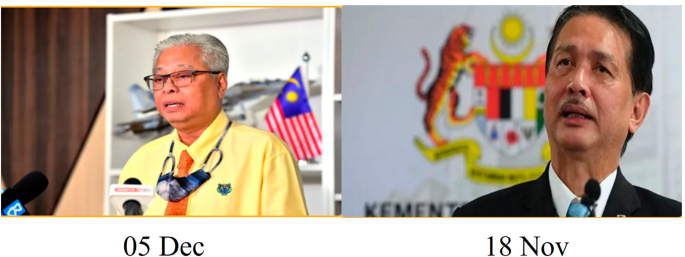
Visual depictions of authority: government spokesman.
The visuals also predominantly feature close-up shots with frontal or slightly oblique angles, emphasizing the facial expressions and upper body actions of the depicted figures. This draws viewers’ attention to their involvement. The frequent use of eye-level representations implies an equal power relationship between the viewers (i.e., Malaysian citizens) and the depicted individuals (i.e., government leaders). The figures typically gaze indirectly at the viewers, presenting serious, unsmiling facial expressions or masked faces, and employing finger gestures. These elements convey their expectations for viewers: a serious and conscientious response to the pandemic.
The corpus also included visual representations of other public authorities in Malaysia. These authorities are depicted through their spokespersons or representatives, as well as objects that symbolically identify them (e.g., state flags, official notices). This type of visual frame was predominantly observed in speeches delivered by these leaders. The role of leaders is crucial, especially during times of crisis, as their engagement with the community often has a lasting impact on the acceptance of information (Perumal et al., 2022). In the face of a social crisis like COVID-19, the central government is expected to take the lead in addressing the citizens, while other authoritative agencies provide support. The collaborative efforts of different authorities in Malaysia demonstrate how joint cooperation can effectively combat the public health crisis of COVID-19 while also combating the spread of misinformation. The visual frames of government speeches thus serve as explicit affirmations of the authority of public authorities. Trusted individuals in the context of social media platforms enhance the perceived legitimacy of the information being disseminated.
Distress
The second most prevalent frame observed is the depiction of distress. In this frame, the pictures create a sense of being in danger and in need of urgent help, triggering emotions of upset, worry, anxiety, and more among viewers. As indicated in Table 2, two main themes contribute to this distress: lockdown/movement control/quarantine (43.04%/n = 34) and economic depression (29.11%/n = 23). These epidemic-related conditions raise significant concerns among the Malaysian public.
The information regarding lockdown/movement control/quarantine is often represented through narrative-driven visuals or official notices. Human characters, such as police officers carrying weapons, and objects symbolizing movement restrictions, convey various ideas related to social “restriction” or freedom “deprivation”. The police or responsible individuals are typically depicted as a generic group, exhibiting features such as protective suits and engaged in similar actions (as shown in the left picture in Fig. 3). Additionally, medium and far shots with oblique angles at eye level are commonly used to depict lockdown-related events. These visual techniques convey a sense of detachment or exclusion, indicating that the depicted participants or events are not closely connected to the shared world of the audience (van Leeuwen, 2008). This photographic strategy does not seem to encourage viewer engagement but rather reinforces a sense of social isolation, which often results in psychological impacts such as distress and uncertainty.
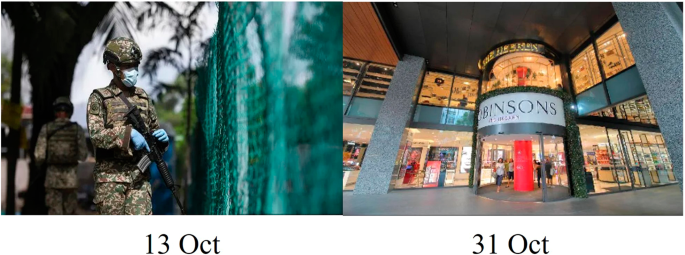
Visual depictions of distress.
On the other hand, visuals depicting economic depression typically exclude human participants. These visual representations encompass various sectors, including the airline industry, hotels, offices, tourist attractions, shops, malls, and restaurants, all of which are affected by the economic downturn. In Fig. 3, the Robinson Mall is captured in the right picture. As one of Malaysia’s most renowned shopping centers, it is depicted as vacant, devoid of customers, and ultimately forced to close its doors. This visual portrayal communicates the message of a “depressed economy during COVID-19”, resonating with the rising unemployment rate and economic uncertainty in Malaysia. Similar to many countries grappling with the pandemic, Malaysia has experienced a significant number of job losses, intensifying financial pressures, and exacerbating stress and anxiety among citizens. Furthermore, COVID-19-related challenges in Malaysia, such as disruptions in transportation, the emergence of new virus variants, and issues concerning foreign employees and illegal immigrants, further amplify the impact of the pandemic. However, it is worth noting that, unlike earlier studies on crisis communication, the visual portrayal of COVID-19 in Malaysia tends to present a lower level of perceived “risk”, since the inherent hazards and resulting outrage—two crucial components of risk communication in social media (Malecki et al., 2020)—are not explicitly depicted or evidently perceived by audiences.
Medical efficacy
This is another prevalent visual frame, accounting for more than one-fifth (23.57 percent) of the visual information analyzed. Within this frame, the majority of examples convey positive, helpful, or hopeful meanings, suggesting the existence of preventatives, cures, or treatments for the virus. The primary content associated with this frame revolves around healthcare workers and medical staff who are involved in COVID-19 testing services, such as nucleic acid testing (60.61%/n = 40), as indicated in Table 2. In Fig. 4, the top-left picture represents healthcare workers, often portrayed as a group rather than individuals, using a distant and oblique angle shot. In most instances, viewers are indirectly presented with the medical actions of these healthcare workers. This approach keeps the audience at a distance, both literally and figuratively, creating an objective perspective of the “effective” and “orderly” measures taken to combat the virus and save lives. Additionally, some healthcare workers and medical staff are depicted in close-up bust photos (top-right picture in Fig. 4), emphasizing their hand actions and testing kits. The inclusion of medical protective clothing in these frames serves to depict healthcare workers in a generic and professional manner, highlighting their commitment to safety.
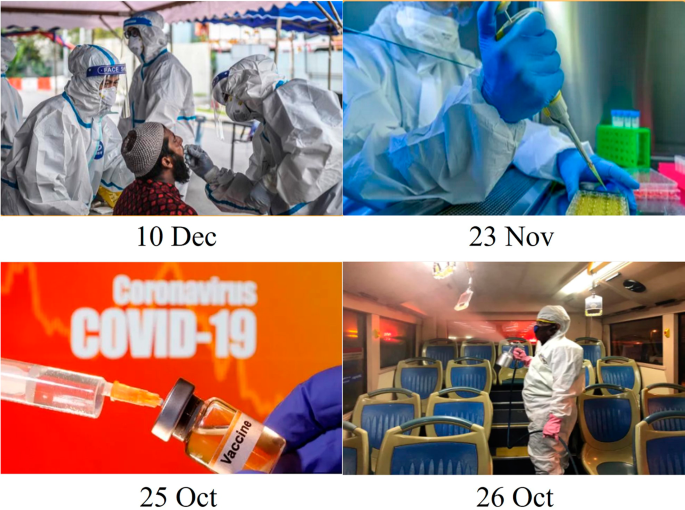
Visual depictions of medical efficacy.
Vaccine-related pictures account for 21.21% (n = 14) of the visuals within the frame of medical efficacy. As seen in the bottom left image of Fig. 4, this type of picture commonly features a vaccine vial and syringe, accompanied by explicit text such as “COVID-19” and “vaccine”. The symmetrical arrangement of verbal elements (coronavirus COVID-19 at the top layer) and visual elements (vaccine vial and syringe at the bottom layer) establishes a connotation of “close interrelation”. This mixed design carries semiotic implicatures in communication. Firstly, the association between the font size and prominence (visual power) of the typographical words is based on a general cognitive understanding that larger font sizes indicate greater prominence or power. The foregrounded “vaccination” action and the medium-sized “vaccine” further create an iconic association of “challenging the overwhelmingly powerful image of COVID-19”. The close-up shot and the presence of human hands/figures, albeit minimal, emphasize the implied focal message of “the imminent vaccine hopefully protecting individuals against the infection”. Additionally, medical efficacy in Malaysia is portrayed through other effective actions, such as the disinfection and sterilization of public amenities, as well as the provision of medical equipment and treatments, as shown in the bottom right image of Fig. 4.
Virulence
Virulence is represented in 12.50% of the visual corpus. The majority (68.57%, n = 24) of visual depictions within this frame portray the spread of the virus as “worsening”, illustrating the increase in infected cases through contour maps (national or regional) painted in bright colors (see left visual in Fig. 5). Statistical diagrams are also used to present information on the number of confirmed cases. These visuals convey the message that the virus is still spreading in Malaysia, emphasizing the need for continued public attention. Around 31.43% of the visuals within this frame consist of graphical representations of the coronavirus, exhibiting varying degrees of abstraction and stylistic preferences. Despite their individual idiosyncrasies, these visual depictions share common characteristics that aid in easy recognition for viewers. For instance, in the right picture of Fig. 5, the viruses appear more concrete than abstract. These icons are primarily created to convey the message that viruses are germs, inherently unpleasant, dangerous, and in need of careful prevention.
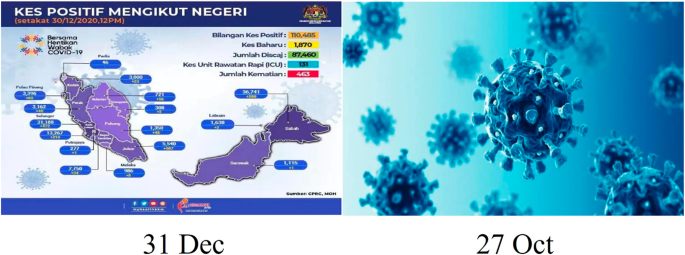
Visual depictions of virulence.
Public responses
Public responses play a significant role in Malaysia’s efforts to combat COVID-19. Despite the imposition of drastic lockdown policies or MCOs, these measures are generally positively understood by the majority of citizens. The effectiveness of such mitigation measures in a public health crisis relies heavily on the cooperation and compliance of society members. The attitudes, knowledge, and practices held by citizens regarding COVID-19 are indeed crucial in determining a society’s readiness to implement intervention plans and follow guidelines from health authorities.
In Malaysia, citizens generally display positive responses to measures aimed at containing the spread of the disease. A majority proportion of 78.26% (n = 18) of pictures depicting public responses showcase cooperation among the people, such as wearing face masks in public (limiting the spread of the virus) and maintaining social distance by lining up in an orderly manner (top-row pictures in Fig. 6). However, there are a few pictures (22%, n = 5) that show non-cooperative attitudes, such as the bottom picture in Fig. 6. In this image, only one lady is seen wearing her face mask inappropriately among a crowd on the street, violating regulations. The use of a relatively distant shot blurs the lady’s face, weakening the emphasis on criticizing her attitude. Other pictures highlight violations of non-compliance with MCOs. While these strict rules effectively minimize the risk of virus transmission, they may be misunderstood by some citizens and perceived as inaccessible or even hostile. Therefore, visuals depicting non-compliance or delinquent behaviors towards preventive measures and MCOs are also present. Even so, the majority of visuals showing cooperative attitudes indicate that these efforts have been effective. As a result, citizens tend to demonstrate a moral obligation to comply with the measures and place trust and confidence in the government’s actions.
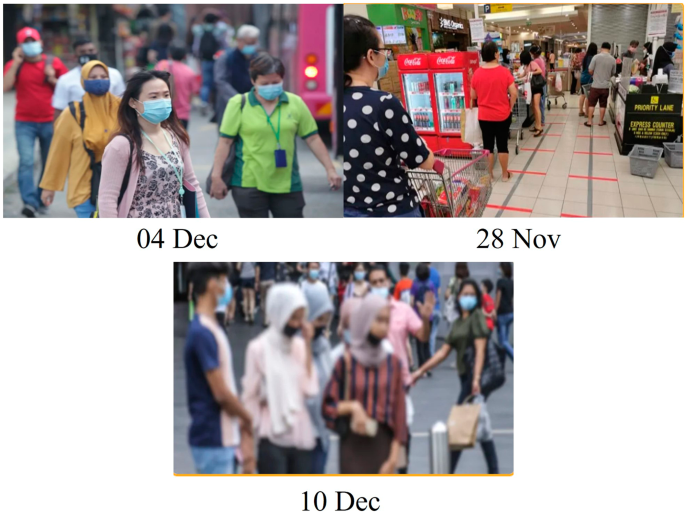
Visual depictions of public responses.
Recovery movement
Despite the numerous challenges posed by COVID-19 in economic and social domains, Malaysia is showing promising efforts to recover, rejuvenate, and reform itself. The recovery movement encompasses various aspects of people’s social lives, including socializing (depicted in the left picture in Fig. 7) and education (depicted in the right picture in Fig. 7). These instances account for two occurrences or 14.29%, respectively, as shown in Table 2. Meanwhile, religious activities and other daily-life-related engagements are depicted minimally (at 7.14%/n = 1, respectively). The participants in these images are represented generically by wearing face masks, symbolizing the collaborative efforts of citizens in promoting the recovery movement. These visuals signify that the government has implemented several strategies to foster determination, resilience, and the gradual return to normalcy, particularly during the final stage of the third wave of COVID-19 in 2020.
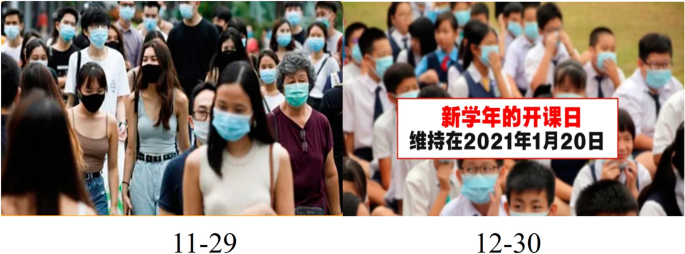
Visual depictions of recovery movement.
Functions of visuals and WeChat official accounts in public health communication
It is worth noting that visuals often serve multiple functions simultaneously, rather than exclusively fulfilling a single purpose in conveying information about the pandemic. Based on the findings, two prominent communicative functions were identified in visual presentations related to COVID-19 discourses. Through a primary qualitative analytical perspective, the researchers categorized these functions based on dominant framed themes and potential meanings, as demonstrated above.
Visuals are primarily employed to illustrate the information presented in corresponding discursive messages. In this process, specific features or core information are selectively highlighted, capturing the attention of the audience. In most cases, visual images provide a clear representation of the central aspects of the textual claims, enabling the audience to quickly grasp the intended message. Accordingly, the visuals used in the WeChat official account serve as concrete evidence supporting informative claims. In other words, the pictures function as a means of “fixating evidence”, where images are utilized to substantiate beliefs (Amann and Cetina, 1988). This evidentiary function attributed to the images often relates to how the world (in this case, the COVID-19 pandemic) is visually depicted. This direct connection to the world is also referred to as the “indexicality” of visual resources.
Previous scholars have argued that visual resources used in web-mediated discourses serve the purpose of attracting readers’ attention and enhancing their perception of information. According to Vaccari and Chadwick (2020), “visuals enhance the transmission of information by helping people to establish and retrieve memories……” and that “individuals process visual information more directly and with less effort than verbal information” (p. 2). An illustration of this can be seen in Fig. 7 (right side), where the primary message sourced from a Chinese newspaper in Malaysia is conveyed through verbal text superimposed at the center of the image, stating, “新学年的开课日维持在2021年1月20日” (the start day of the new school year will be January 20, 2021). The Chinese-language message and the visual content work together to reinforce the key information of the entire news report regarding the “start day of school”, utilizing vivid-colored images and contrasting colors for emphasis. Even without textual messages incorporated into the images, audiences are still capable of comprehending the intended information. Many visuals are therefore employed to attract attention while supporting the producers’ claims about the central information. For instance, an image depicting a vaccine vial may suggest the effectiveness of vaccinations in preventing COVID-19 infection.
Moreover, visuals serve the dual purpose of eliciting emotional responses in audiences and framing messages to empower them. This empowerment, as suggested by Lakoff (2010), enables individuals in society to be aware of how they should act in response to requests. Consequently, socio-cultural communication often involves appealing to appropriate social norms to facilitate emotional and behavioral responses from audiences (Hyland-Wood et al., 2021). Visual communication, therefore, needs to consider both the practical and psychological aspects of eliciting desired responses, including the audience’s ability, opportunity, and motivation to engage in recommended actions. In this particular study, communicators were observed to utilize themed pictures to promote desirable social norms, framing both descriptive norms (showing individuals engaged in desired behaviors, such as highlighting medical efficacy and cooperative public responses) and injunctive norms (conveying that certain actions are the right thing to do, such as getting vaccinated) (Schultz et al., 2007). Audiences are then intrinsically motivated to foster their civic engagement, which includes reinforcing shared values and avoiding becoming disease vectors during this pandemic (Jordan et al., 2021).
The mobile media platform used in this study, specifically the WeChat official account, aims to communicate messages of solidarity and optimism in a subtle manner (Gong et al., 2022). Solidarity in this context refers to the agreement and support among members of a group. During a public health crisis, this alignment and support can come from various sources and involve diverse social groups. In fact, through visual images, both at the authoritative and public levels, this study portrays connotations of “steadiness” and “harmony” by highlighting governmental responsibility, preparedness, and public cooperation, among other factors.
While distress is visually framed as “silent” and “depressed” in this study, extreme and uncontrolled behaviors were not depicted visually throughout the three-month period of the third wave of COVID-19. The people portrayed on the WeChat official account tend to exhibit patience and self-restraint rather than resorting to violence, attacks, hysteria, or psychological trauma as responses to the pandemic in their community (Abdullah, 2020; Malecki et al., 2020). The visual framing employed in this study rhetorically softens the sense of panic, potentially reducing anxiety. By emphasizing “calmness” and “optimism” in visual framing, the intention is to reinforce the idea of being in the process of recovery. Overall, visuals used in crisis communication have the potential to foster a shared belief in togetherness and encourage audiences to set aside their differences and come together with a heightened sense of collective responsibility (van Zomeren et al., 2008).
link







